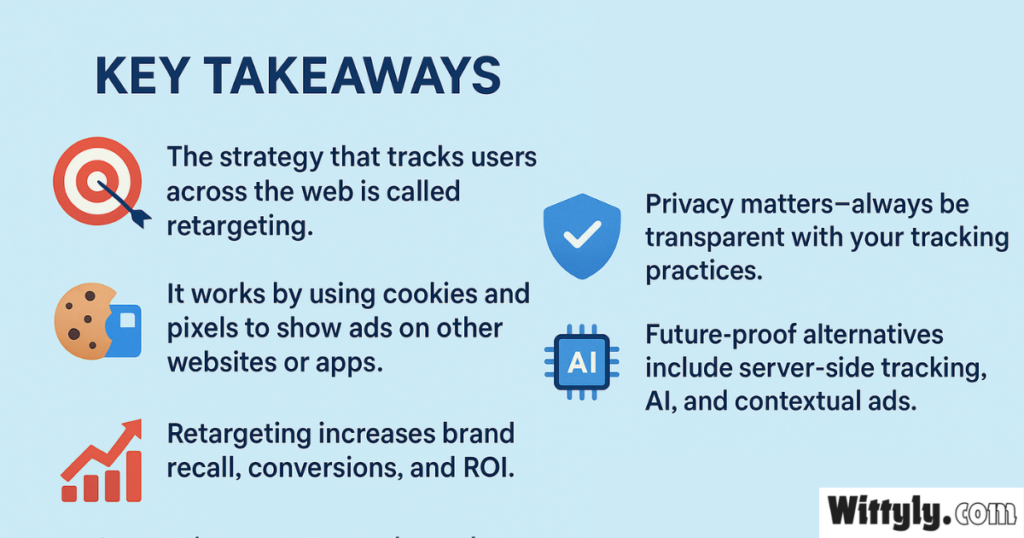Have you ever wondered how ads seem to follow you wherever you go online? That’s not a coincidence—it’s a powerful digital marketing strategy called retargeting or remarketing. In this article, we’ll break down what is the digital marketing strategy that tracks users across the web? How does it work? Why is it effective? And what ethical considerations does it bring? We’ll also explore advanced techniques, industry trends, case studies, and privacy-friendly alternatives to give you a complete view.
What Is the Digital Marketing Strategy That Tracks Users Across the Web?
The digital marketing strategy that tracks users across the web is known as retargeting (also called remarketing). This strategy uses browser cookies and tracking pixels to follow users who’ve visited a website but didn’t complete a desired action, like making a purchase or signing up for a newsletter.
When users leave the site, retargeting tools allow businesses to display ads to them on other websites, social media platforms, or even in mobile apps. This constant brand visibility helps bring users back to complete what they started.
How Does Retargeting Work?
To understand what is the digital marketing strategy that tracks users across the web, let’s explore the process step by step:
- Pixel Installation: A small piece of code (pixel) is embedded in a webpage.
- User Visits Site: A visitor lands on your site and the pixel drops a cookie in their browser.
- User Leaves Site: They leave without converting (e.g., no purchase or form submission).
- Ads Are Triggered: The cookie triggers your ads to appear on other sites or platforms they visit.
- User Clicks & Returns: Seeing your brand again may convince them to return and convert.
Popular platforms like Google Ads, Facebook Ads, LinkedIn Ads, and even TikTok Ads support retargeting via these tracking mechanisms.
Why Retargeting Works So Well
Retargeting is one of the most effective digital marketing strategies—and here’s why:
- It targets warm leads: You’re advertising to users who already know your brand.
- Increases conversion rate: Users who are retargeted with display ads are 70% more likely to convert.
- Boosts brand recall: Seeing your brand repeatedly strengthens memory retention.
- Improves ROI: Retargeting leads to a higher return on ad spend compared to cold traffic campaigns.
- Creates urgency: You can create FOMO (Fear Of Missing Out) using time-limited offers.
If you’re asking “what is the digital marketing strategy that tracks users across the web,” it’s likely because you’ve already seen it work—perhaps even on you.
Types of Retargeting Explained
There are several kinds of retargeting strategies you can implement, each suited to different goals:
1. Pixel-Based Retargeting: This is the most common form, triggered by page visits. It’s fast and automatic.
2. List-Based Retargeting: This uses email lists or customer databases to serve ads on platforms like Facebook.
3. Search Retargeting: Serves ads to users who have searched specific terms on search engines.
4. Site Retargeting: Focuses on users who interacted with specific pages on your site.
5. CRM Retargeting: Integrates with your customer relationship management system to personalize ads based on behavior.
6. Dynamic Retargeting: Automatically creates tailored ads with products a user viewed, common in e-commerce.
Each strategy enhances your ability to reconnect with users based on intent and interest.
Where Does Retargeting Happen?
You’ve likely seen retargeting in action on:
· Display Ads: Banners across websites you visit.
· Social Media Ads: Facebook, Instagram, TikTok, Twitter, LinkedIn.
· Video Platforms: YouTube pre-roll ads based on browsing history.
· Mobile Apps: Retargeted ads appear during gameplay or app use.
· Email Campaigns: Triggered messages to re-engage users.
This omnichannel presence keeps your brand top of mind, no matter where your audience goes.
Advanced Retargeting Techniques
To enhance your strategy, consider these advanced methods:
· Segmented Campaigns: Separate new visitors, returning users, and cart abandoners for more personalized ads.
· Frequency Caps: Prevent ad fatigue by limiting how often users see the same ad.
· A/B Testing Ads: Try multiple creatives and calls to action.
· Sequential Retargeting: Show different ads based on user journey stages.
· Geo-Based Retargeting: Serve location-specific ads for events or local offers.
These techniques fine-tune performance and deliver higher conversion rates.
Tools That Help You Retarget Users
If you’re ready to implement this strategy, use these powerful tools:
· Google Ads Remarketing
· Meta Pixel (Facebook/Instagram)
· LinkedIn Insight Tag
· Twitter Pixel
· AdRoll
· Criteo
· HubSpot and Mailchimp (CRM-based)
· TikTok Ads Pixel
· Perfect Audience
Most tools integrate with your website or CRM and offer detailed analytics to track campaign success.
Real-World Examples of Retargeting
1. E-commerce Cart Recovery:
o You browse a fashion store and abandon your cart.
o A few hours later, you see a 15% discount ad on Instagram.
2. Online Learning:
o You visit a page about digital marketing courses.
o You’re later shown a testimonial video or free trial offer on YouTube.
3. Travel Bookings:
o You search for hotels in Paris but leave without booking.
o Later, an ad offers you hotel deals in Paris.
These examples illustrate what is the digital marketing strategy that tracks users across the web in everyday scenarios.
Ethical Concerns and Privacy Compliance
Tracking users across the web naturally raises concerns about privacy. Address these with transparency:
· Update Your Privacy Policy: Clearly mention cookie usage and data tracking.
· Use Consent Banners: Prompt users to accept or decline cookies.
· Provide Opt-Out Links: Let users opt out of ad personalization.
· Follow Regional Laws: Adhere to GDPR (Europe), CCPA (California), and other data protection rules.
Being transparent builds trust and keeps your business compliant.
Future of Retargeting: What’s Next?
As privacy regulations evolve and third-party cookies phase out, marketers are pivoting to first-party data and alternative methods:
· Server-Side Tracking: More secure and less reliant on browsers.
· Contextual Advertising: Targets users based on the content they’re viewing.
· Cohort-Based Ads: Groups users by behavior patterns rather than tracking individuals.
· AI-Powered Segmentation: Uses machine learning to predict user behavior.
These methods ensure that what is the digital marketing strategy that tracks users across the web evolves with privacy in mind.
Alternatives to Cookie-Based Retargeting
While cookies are the backbone of current tracking, here are cookie-free options:
· Contextual Targeting: Match ads to relevant website content.
· Influencer Collaborations: Leverage trusted voices in your niche.
· Content Marketing: Educate and attract users organically.
· Email Retargeting: Segment your email list based on clicks and opens.
These approaches are useful if you want to maintain engagement without tracking user activity across multiple platforms.

FAQs
1. What is the digital marketing strategy that tracks users across the web?
It’s known as retargeting, which uses cookies and pixels to show personalized ads to past site visitors.
2. Is retargeting effective for small businesses?
Yes! Even with small budgets, platforms like Meta and Google Ads allow highly targeted campaigns that improve ROI.
3. How do I start using retargeting for my business?
Set up tracking pixels on your website, choose a retargeting platform, define your audience, and launch a campaign.
4. Is retargeting legal?
It is legal, but businesses must comply with privacy regulations such as GDPR, CCPA, and ensure user consent.
5. Are there alternatives to retargeting using cookies?
Yes. You can try contextual ads, first-party data, influencer marketing, and AI-driven segmentation.
Now that you know exactly what is the digital marketing strategy that tracks users across the web, you can use this knowledge to implement smarter, privacy-conscious marketing campaigns that truly resonate with your audience.
A Note from Wittyly
At Wittyly, we believe in breaking down complex digital concepts into clear, actionable insights. Whether you’re a small business owner or a seasoned marketer, understanding strategies like retargeting can elevate your brand’s reach and performance. Our goal is to empower you with knowledge that’s practical, ethical, and future-focused. Stay smart, stay witty — and let us help you grow online the right way.
Wittyly is a content-driven platform powered by a team of SEO experts, writers, and digital marketers who are passionate about helping businesses grow online. From actionable marketing guides to expertly crafted branding strategies, Wittyly delivers high-quality, well-researched content you can trust. Every article is professionally written and thoroughly proofread to ensure accuracy, clarity, and value for readers across industries.
Email: Contact@wittyly.com



